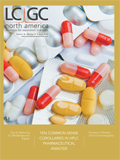The Vital Role of Blanks in Sample Preparation
LCGC North America
Blanks are important in the pursuits of quality control and robust quantitative analytical methods, but many analysts don’t fully understand their value, or how to use them correctly.
When I teach my instrumental analysis course, one of my favorite experiments is when the students receive a bottle of tonic water, and then are asked to collect urine samples after consuming it. Following a liquid–liquid extraction, levels of urinary quinine are determined via fluorescence spectroscopy. The experiment provides a great example of the adsorption, distribution, metabolism, excretion phenomenon important to pharmacology and toxicology. Before consuming the tonic water, students are asked to collect a urine sample to use as a blank, because urine may contain an endogenous compound that fluoresces on the shoulder of the quinine fluorescence band. Surprisingly, although the students collect, treat, and analyze the blank appropriately, they often do nothing with the data they obtain.
The concept of blanks-samples lacking the analyte of interest used to determine or track the source of contamination or sample degradation and taken through the analytical process-is somewhat straightforward. However, it was noted fairly recently that even ASTM International (via Committee D19) is still struggling with defining what constituents should be present (1). Because blanks are used to trace sources of artificially introduced contamination, it is important to consider their particular analysis, and any potential problems, in determining necessary blanks, and often more than one type of blank is needed.
Blanks serve a vital role in quantitative analysis, and are often required by regulatory agencies as part of their quality control schemes. This month's column explores the various types of blanks, and their use to provide further insight to sample preparation schemes. For example, appropriate use of blanks recently solved a riddle in our laboratory. The source of errant peaks in an ultrahigh-pressure liquid chromatography (UHPLC) separation were difficult to identify until a solvent (reagent) blank was used, and it was determined that inexperienced researchers had introduced contamination directly into the source bottle of acetonitrile used in the analysis.
Types of Blanks
Blank samples are collected, stored, treated, and analyzed in a manner as close to that for authentic samples as possible to account for contaminants and other potential interferents or potential sample degradation. Any analytical signal emanating from a blank sample that is absent in a blank solvent can be attributed to contamination. Proper handling and treatment of blanks is absolutely essential, since, in many cases, analytical results are calculated by subtracting the contribution of the blank to the analytical signal. Because blanks may be collected at any point during an analytical scheme, they may account for different items that may arise during the analysis. Thus, it is important to gain an understanding of the terminology used, and what these blanks potential correct. Examples of different types of blanks, primarily gleaned from U.S. Geological Survey (USGS), Environmental Protection Agency (EPA), and Food and Drug Administration (FDA) websites, include, but are not limited to
- Ambient blank: Blank sample placed in the type of container used for the authentic sample, opened during sample collection and exposed to the ambient atmosphere.
- Calibration blank: This analyte-free media is used with prepared standards to calibrate the analytical instrument (establishing a "zero" setting) and to confirm the absence of interferences in the analytical signal. It is important to note that this blank is different than the field blank (see below), but can be used in combination with the field blank to help identify sources of contamination.
- Equipment blank: Blank sample that is processed through the sample equipment, typically during collection, in a matter similar to the sample.
- Field blank: A common type of blank and the most comprehensive, it is subjected to sample collection, transportation, preservation and storage, and laboratory analysis. Field blanks can determine contaminants or analytical errors, or bias, stemming from sample collection and analysis. Such contamination may result from bottles and other glassware, sampling equipment and conditions, preservatives, transportation and storage, or the laboratory analysis.
- Filter blank: A very specific type of blank where the blank solution is filtered through the same apparatus used in processing authentic samples.
- Fortified method blank: This type of method blank (see below) is spiked with analyte. Not to be confused with spike samples, used to determine analyte recovery, fortified method blanks are used to assess analyte degradation during analysis procedures.
- Matrix blank: These blanks contain all sample components except the analytes of interest and are subject to all sample processing steps. They are used to measure the presence of significant interference from the matrix.
- Method blank: Method blanks are used to determine background contamination or interferences in the analytical system. Like other blanks, the method blank is composed of the sample matrix, absent the analyte, and all reagents from the analytical procedure in appropriate concentrations.
- Preservation blank: A blank sample treated with any preservatives used in the analytical scheme. When compared with a blank without the preservative, the effect of this agent can be determined.
- Reagent blank: Background interferences and contamination from the chemicals and analytical systems used are measured with reagent blanks. All analytical reagents are added to the blank matrix in the same proportion specified in the analytical method, but are not carried through the complete analysis scheme.
- Trip blank: A blank sample taken during the sample collection to account for sample changes during transfer from the collection site to the laboratory. Trip blanks are prepared during the sample collection and are especially valuable for volatile compounds and those subject to degradation by factors such as exposure to light, bacteria, or freeze–thaw cycles.
Figure 1 shows the relationship between the most common types of blanks and their coverage-that is, the breadth for which they correct (including sample matrix, reagents, and equipment) (2). It is worthwhile to note that blank samples are separate from reference samples, control samples, spiked samples, and replicate samples, each of which serve a distinct purpose. According to EPA standards (3), acceptable blanks have target analyte concentrations less than half of the low limit of quantification. Exceptions for blanks containing analyte levels greater than the acceptance limits exist, and criteria for selecting blanks may vary between regulatory methods. Similarly, method blanks are run periodically within each suite of samples to assess sample carryover.

Figure 1: Depiction of the coverage, from sample to laboratory to field, of different sources of contamination and sample blanks used to account for them (modified from reference 2).
Detector signals caused by the blank can lead to refinement of the analysis scheme. Loss of sample resulting from volatilization, for example, may warrant changes in sample collection, transport, or storage. If interferences are present, they may be of two types. Additive interferences are caused by contaminants added to the sample in a consistent amount. For example, if the same volume of solvent is used for a given sample size, regardless of analyte concentration, and this use of solvent adds contaminant, an additive interference results. If the contaminant cannot be determined and removed, a fairly safe assumption is that the signal caused by the contaminant can be subtracted from the observed analytical signal. In such a case, the reported results should be labeled as corrected. Multiplicative interferences result from variations in the amount of contaminant due to its source. For example, when different aliquot volumes are used in sample transfer or preparation, as analyte concentration increases, the contaminant levels also increase by a corresponding amount. These interferences can be corrected only by separation methods or selective detection. In determining interferences, a dummy analysis, such as injection of an empty syringe (air) into a gas chromatograph, can help track down the nature of the interference (4).
Regardless of how a sample blank is treated, it is clear that the signal from the blank becomes especially important at low analyte concentrations. Thus, it has a role in the determination of the smallest amount of analyte which may be detected. Armbruster and Pry discuss three descriptors of this smallest amount of detectable analyte (5). The limit of blank (LOB) comes from replicate analysis of blank samples containing no analyte and is the highest apparent analyte concentration from this analysis:
LOB = meanblank + 1.645(SDblank).
The limit of detection (LOD) is the lowest feasible analyte detection distinguishable from the LOB:
LOD = LOB + 1.645(SDlow concentration sample)
The limit of quantitation (LOQ) is greater than or equal to the LOD and represents the analyte amount which can be reliably detected at predetermined levels of precision (measured as standard deviation or other statistical methods). Figure 2 graphically depicts the statistical relationship between these limits. It is clear that knowledge of the LOB is necessary to establish detection limits.

Figure 2: Statistical relationship between LOB, LOD, and LOQ (reproduced from reference 5). The width of the distribution around each value is an indication of statistical precision and, at the 95% confidence interval, some overall between each limit exists.
Sample Applications from the Determination of Blank Samples
In this column's opening paragraphs, we observed two examples of the use of blanks. The urine sample collected before consumption of tonic water is a matrix blank. If we assume that the concentration of the endogeneous interference, when corrected for specific gravity, is constant over the duration of the sample collection period, the endogenous interferent is an additive interference and the blank, or background, signal may be subtracted from the analytical measurement. In the case of the contaminated acetonitrile causing spurious peaks in the UHPLC chromatogram, the acetonitrile contaminant is a multiplicative interference if the amount of acetonitrile used varied with sample size, and the issue was resolved by using fresh, uncontaminated solvent.
Let's consider a final example. A farmer, wishing to measure the distribution of fertilizer applied to a field, contracts an analytical laboratory for this work. A total of 50 soil samples was collected in a grid pattern across a section (640 acres) of land. In reviewing the analysis results, all samples show a statistically similar level of applied fertilizer, except one sample which reported results 15 times greater than the others. From a purely statistical point of view, one could run a Q-test or some other test to determine that this large value is an outlier that can be discarded. However, such a statistical test would not account for several possibly real scenarios. What if this location was where the farmer refilled the sprayer? What if the local environment had a different runoff pattern than the rest of the field, or a different soil composition? The correct use of appropriate blanks, along with replicate sampling and analysis, can be used to undercover potential causes behind this single high reported value.
Conclusion
Blank samples, along with replicates, standards, and spiked samples, are crucial to quality control and the development of robust quantitative analytical methods. It is worth the time for analysts to understand the types of blanks, their need (what do they correct for), and their use.
References
(1) D. Coleman and L. Vanatta, Amer. Lab.42(10), (2010) (https://www.americanlaboratory.com/914-Application-Notes/1114-Part-40-Blanks/). https://www.epa.gov/sites/production/files/2015-06/documents/blanks.pdf
(2) EPA Method SW-846 Update V Revision 2, July 2014 (https://www.epa.gov/sites/production/files/2015-10/documents/chap1_1.pdf).
(3) M.F. Vitha, P.W. Carr, and G.A. Mabbott, J. Chem. Educ.82(6), 901–902 (2005).
(4) D.A. Armbruster and T. Pry, Clin. Biochem. Rev.29 (Supple 1), S49–S52 (2008).
ABOUT THE AUTHORS
Douglas E. Raynie

Douglas E. Raynie "Sample Prep Perspectives" editor Douglas E. Raynie is a Department Head and Associate Professor at South Dakota State University. His research interests include green chemistry, alternative solvents, sample preparation, high-resolution chromatography, and bioprocessing in supercritical fluids. He earned his PhD in 1990 at Brigham Young University under the direction of Milton L. Lee. Raynie is a member of LCGC's editorial advisory board. Direct correspondence about this column via e-mail to LCGCedit@ubm.com


.png&w=3840&q=75)

.png&w=3840&q=75)



.png&w=3840&q=75)



.png&w=3840&q=75)







